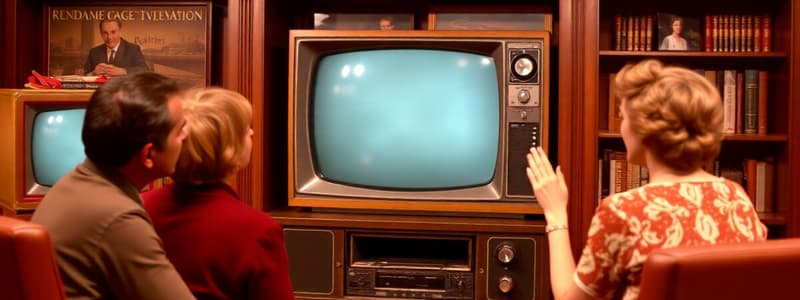Podcast
Questions and Answers
Philo T. Farnsworth's television system used thermionic valves rather than cathode ray tubes for image capture.
Philo T. Farnsworth's television system used thermionic valves rather than cathode ray tubes for image capture.
False (B)
The utilization of television to reach voters during political campaigns only emerged in the 21st century.
The utilization of television to reach voters during political campaigns only emerged in the 21st century.
False (B)
Television's influence on American society is limited to entertainment, with minimal impact on social issues such as race relations and gender roles.
Television's influence on American society is limited to entertainment, with minimal impact on social issues such as race relations and gender roles.
False (B)
Television's ability to create a mass media experience leads primarily to the fragmentation, rather than consolidation, of public opinion due to diverse programming options.
Television's ability to create a mass media experience leads primarily to the fragmentation, rather than consolidation, of public opinion due to diverse programming options.
Educational programs on television solely serve as entertainment and do not contribute to the informational needs, especially of children without access to traditional classrooms.
Educational programs on television solely serve as entertainment and do not contribute to the informational needs, especially of children without access to traditional classrooms.
Early television broadcasts had no effect on culture, politics, or elections in the United States.
Early television broadcasts had no effect on culture, politics, or elections in the United States.
Presidential debates broadcast on television allow millions of viewers to form opinions on candidates.
Presidential debates broadcast on television allow millions of viewers to form opinions on candidates.
Advertisers may pressure TV networks to incorporate product placements or other promotional integrations into programming.
Advertisers may pressure TV networks to incorporate product placements or other promotional integrations into programming.
Product placements within TV shows can range from subtle mentions of brands to overt scenes featuring products.
Product placements within TV shows can range from subtle mentions of brands to overt scenes featuring products.
Product placement is almost universally enjoyed by viewers, with very few considering it intrusive.
Product placement is almost universally enjoyed by viewers, with very few considering it intrusive.
The term 'fake news' originated from a political science journal, before being popularized by reality television.
The term 'fake news' originated from a political science journal, before being popularized by reality television.
Reality TV's influence is limited to entertainment, with no impact on areas such as political discourse.
Reality TV's influence is limited to entertainment, with no impact on areas such as political discourse.
Personalized viewing experiences, like recommendations based on viewing habits, are expected to decrease as technology advances.
Personalized viewing experiences, like recommendations based on viewing habits, are expected to decrease as technology advances.
Due to fierce competition, networks place a decreasing emphasis on original programming, instead favouring syndicated content.
Due to fierce competition, networks place a decreasing emphasis on original programming, instead favouring syndicated content.
Reality TV has had minimal impact on American culture and politics, with its effects being largely superficial and transient.
Reality TV has had minimal impact on American culture and politics, with its effects being largely superficial and transient.
Television has been used as a tool for propaganda, but only by political parties, not interest groups.
Television has been used as a tool for propaganda, but only by political parties, not interest groups.
Political campaigns utilize TV ads solely to inform the public about policy details.
Political campaigns utilize TV ads solely to inform the public about policy details.
Television’s influence on public opinion is limited to news programs, excluding other forms of media like talk shows.
Television’s influence on public opinion is limited to news programs, excluding other forms of media like talk shows.
Television's role in shaping public opinion is confined to political matters, not social issues.
Television's role in shaping public opinion is confined to political matters, not social issues.
Television's impact on public opinion is primarily due to its inability to reach large audiences quickly and consistently.
Television's impact on public opinion is primarily due to its inability to reach large audiences quickly and consistently.
News programs on television have no effect on public discourse; they simply report events without influencing the topics discussed.
News programs on television have no effect on public discourse; they simply report events without influencing the topics discussed.
The shift in societal views toward more liberal attitudes regarding teenage independence has no correlation with the popularity of reality TV shows.
The shift in societal views toward more liberal attitudes regarding teenage independence has no correlation with the popularity of reality TV shows.
The first television broadcast was made in the United States.
The first television broadcast was made in the United States.
Television news is universally accepted as completely accurate and reliable.
Television news is universally accepted as completely accurate and reliable.
The portrayal of minorities on television has consistently been diverse and accurate since the inception of television.
The portrayal of minorities on television has consistently been diverse and accurate since the inception of television.
Studies definitively show that TV violence has no impact on children's behavior or attitudes.
Studies definitively show that TV violence has no impact on children's behavior or attitudes.
Advertising has minimal influence on the content and focus of television programming.
Advertising has minimal influence on the content and focus of television programming.
Flashcards
Philo T. Farnsworth
Philo T. Farnsworth
He invented the first electronic television system in 1928 using cathode ray tubes.
Golden Age of Television
Golden Age of Television
The period in the 1950s when television became a dominant force in American homes, featuring iconic shows.
Dominant TV Networks (1950s)
Dominant TV Networks (1950s)
CBS, NBC, and ABC were the major networks that shaped early television programming and culture.
Mass Media Creation
Mass Media Creation
Signup and view all the flashcards
Educational Potential of TV
Educational Potential of TV
Signup and view all the flashcards
Presidential Debates on TV
Presidential Debates on TV
Signup and view all the flashcards
TV's Impact on Social Issues
TV's Impact on Social Issues
Signup and view all the flashcards
TV in Political Campaigns
TV in Political Campaigns
Signup and view all the flashcards
TV Schedule Manipulation
TV Schedule Manipulation
Signup and view all the flashcards
Product Placement in TV
Product Placement in TV
Signup and view all the flashcards
Reality TV's Cultural Impact
Reality TV's Cultural Impact
Signup and view all the flashcards
Reality TV and Political Discourse
Reality TV and Political Discourse
Signup and view all the flashcards
Streaming Services
Streaming Services
Signup and view all the flashcards
Personalized Viewing Experiences
Personalized Viewing Experiences
Signup and view all the flashcards
Original Programming
Original Programming
Signup and view all the flashcards
Advertisers Pressure
Advertisers Pressure
Signup and view all the flashcards
Reality TV and the Polarization of Society
Reality TV and the Polarization of Society
Signup and view all the flashcards
Reality TV Format
Reality TV Format
Signup and view all the flashcards
Presidential Debates
Presidential Debates
Signup and view all the flashcards
Propaganda
Propaganda
Signup and view all the flashcards
Manipulation
Manipulation
Signup and view all the flashcards
Shaping Public Opinion
Shaping Public Opinion
Signup and view all the flashcards
TV's Reach
TV's Reach
Signup and view all the flashcards
Agenda Setting
Agenda Setting
Signup and view all the flashcards
Cultural Norms
Cultural Norms
Signup and view all the flashcards
First TV Broadcast
First TV Broadcast
Signup and view all the flashcards
TV as News Source
TV as News Source
Signup and view all the flashcards
Criticism of TV News
Criticism of TV News
Signup and view all the flashcards
Minority Portrayal
Minority Portrayal
Signup and view all the flashcards
Increasing Representation
Increasing Representation
Signup and view all the flashcards
Behind-the-Scenes Diversity
Behind-the-Scenes Diversity
Signup and view all the flashcards
Impact of TV Violence
Impact of TV Violence
Signup and view all the flashcards
Advertising's Influence
Advertising's Influence
Signup and view all the flashcards
Study Notes
- Television's history in America started in the early 1900s with experimental broadcasts.
- Philo T. Farnsworth invented the first electronic television system in 1928, using cathode ray tubes.
- Television became widely available in American homes in the late 1940s.
Golden Age of Television
- The 1950s are known as the Golden Age of Television.
- CBS, NBC, and ABC dominated broadcasting during this period.
- Popular shows included "I Love Lucy," "Leave It to Beaver," and "The Tonight Show."
- These shows influenced American culture and social norms.
- Television became an important tool in political campaigns, with candidates using TV ads.
- Barack Obama used social media and online advertising successfully in his 2008 and 2012 campaigns.
Impact on American Society
- Television has significantly shaped American culture and politics.
- It has influenced how Americans think, act, and interact.
- It has also affected social issues such as race relations, gender roles, and sexuality.
- Television created mass media, allowing programs to reach large audiences and influence public opinion.
- Presidential debates are broadcast live, allowing millions to form their own opinions.
- Television has the potential for education through specialized educational programs.
- Television has contributed to cultural homogenization while also providing a platform for diverse voices.
Impact on American Politics
- Presidential debates have become integral to the political process.
- The first televised debate was in 1952 between Dwight D. Eisenhower and Adlai Stevenson, with over 60 million viewers.
- Television has been used for propaganda and manipulation by politicians and interest groups.
- During the Cold War, it promoted anti-communist sentiments.
- Political campaigns use TV ads to sway public opinion.
- Television shapes public opinion through news programs and talk shows.
- Politicians must craft messages carefully to resonate with the audience.
- It has played a role in shaping public opinion on social issues.
Shaping Public Opinion
- Television shapes public opinion by influencing how people perceive political events and issues.
- It reaches large audiences quickly and consistently, making it a powerful tool for persuasion.
- News programs set the agenda for public discourse.
- Television shapes cultural norms and values through various shows.
- Reality TV shows may have contributed to more liberal attitudes towards teenage independence.
News Source
- The first television broadcast was on July 13, 1928, by John Logie Baird in Scotland.
- Regular TV broadcasts in the United States began in 1947 with NBC's "Mary Kay and Johnny."
- Television provides breaking news, sports updates, weather reports, entertainment news, and political coverage.
- Concerns exist regarding the accuracy and sensationalism of television news.
Portrayal of Minorities
- Minority groups have historically been underrepresented or stereotypically portrayed on television.
- Efforts have been made to increase representation, such as shows like "Black-ish" and "Fresh Off the Boat."
- Progress is slow, and many minority groups are still underrepresented.
- There is a lack of diverse writers and producers behind the scenes.
Impact of Violence on Children
- Exposure to violent media can lead to desensitization, increased aggression, and decreased empathy in children.
- TV violence may reinforce gender stereotypes and promote anti-social behaviors.
- It has been linked to increased fear and anxiety levels.
- Parents and policymakers need to limit children's exposure to violent programs.
Advertising
- Advertisers pay for airtime during TV shows, influencing programming decisions.
- Networks tailor programming to appeal to advertisers, sometimes moving shows or favoring certain genres.
- Advertisers exert pressure for product placements within programming.
Reality TV
- Reality TV has significantly impacted American culture.
- Phrases and concepts from reality TV have become part of everyday language, such as "fake news."
- Many reality TV stars have achieved fame beyond their shows.
- Reality TV's format, involving confrontation and conflict, has been compared to modern politics, contributing to polarization.
Future of Television
- Increased streaming services are expected.
- More personalized viewing experiences are anticipated.
- Greater emphasis on original programming is likely.
- Streaming services like Netflix, Hulu, and Amazon Prime Video are growing.
- Algorithms are used to recommend content based on viewing habits. Networks are creating exclusive content to stand out in a competitive market.
Studying That Suits You
Use AI to generate personalized quizzes and flashcards to suit your learning preferences.





